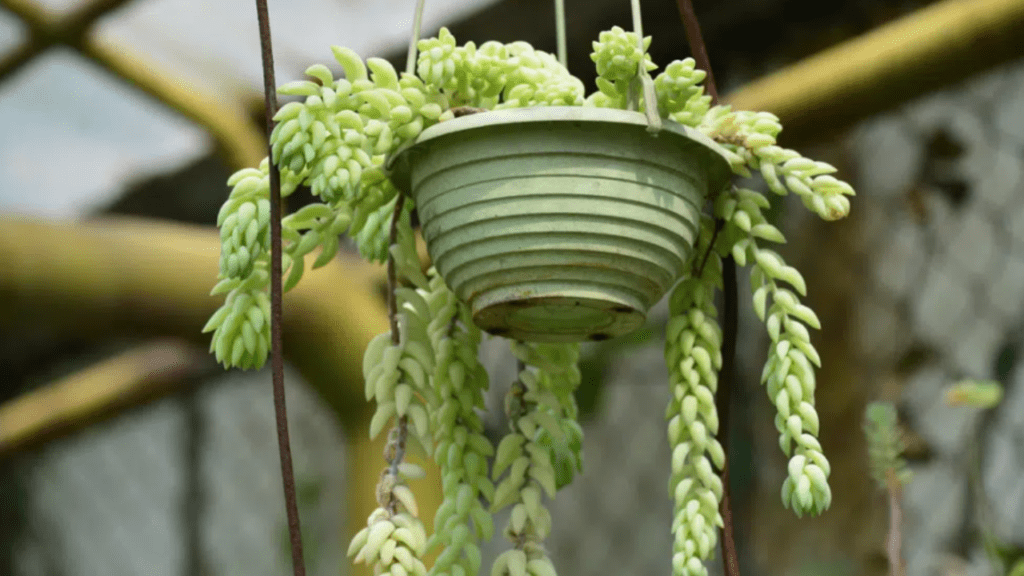
Ultimate Guide to Hanging Succulent Plants: Care Tips and Stunning Display Ideas
Succulent plants are a beautiful and low-maintenance addition to any home or garden, and hanging succulents can add a unique and eye-catching element to your space. In this ultimate guide, we’ll cover everything you need to know about caring for and displaying your hanging succulent plant. From essential care tips to creative and stunning display ideas, this post has all the information you need to create a beautiful and thriving succulent display in your home or garden. Whether you’re a seasoned succulent enthusiast or new to the world of hanging plants, this guide will provide you with valuable insights and inspiration. So, let’s dive in and explore the wonderful world of hanging succulent plant!
Hanging succulent plants are a beautiful and unique addition to any home or garden, but they do require specific care to thrive. It’s important to ensure that they receive the right amount of sunlight, water, and nutrients to keep them healthy and vibrant. When caring for hanging succulents, it’s important to choose the right type of pot or planter to allow for proper drainage and air circulation. You’ll also want to make sure to use a well-draining soil mix to prevent root rot. In terms of display, there are many creative and stunning ways to showcase your hanging succulents, whether it’s creating a cascading wall display or arranging them in a hanging macrame planter. By following our care tips and display ideas, you can create a beautiful and thriving succulent display that will enhance the beauty of your home or garden.
Table of Contents
ToggleTypes of Hanging Succulent Plants
Discuss various species suitable for hanging
There are several types of succulent plants that are suitable for hanging. Some popular options include String of Pearls, Burro’s Tail, String of Bananas, and String of Hearts. These plants have trailing or cascading stems that make them perfect for hanging planters or macrame hangers. They add a unique and beautiful touch to any space and are relatively low-maintenance, making them a great choice for both beginner and experienced gardeners. When choosing hanging succulent plant, consider the amount of sunlight and water they require, as well as their growth habits to ensure they will thrive in your chosen location. With the right care and attention, these hanging succulent plants can add a stunning and striking element to your home or garden.
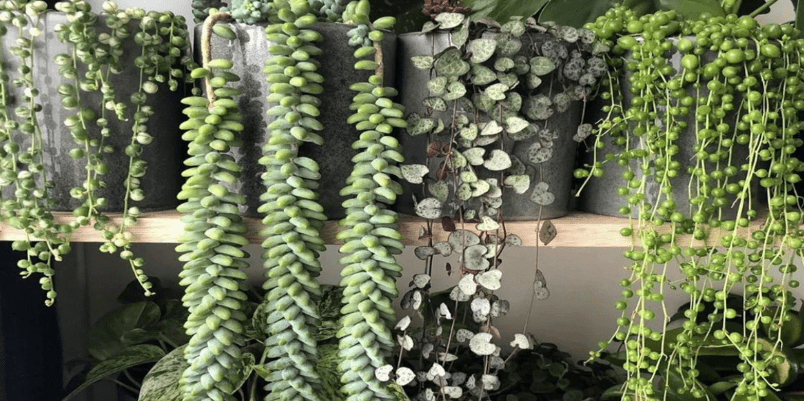
Highlight unique features and care requirements
Succulent plants are a great addition to any home or garden. They are known for their unique and striking appearance, making them a popular choice for plant enthusiasts. When it comes to hanging succulent plant, there are several types that are suitable for this purpose. Some popular options include String of Pearls, Burro’s Tail, String of Bananas, and String of Hearts. These plants have trailing or cascading stems, making them perfect for hanging planters or macrame hangers.
In terms of care requirements, succulent plants are known for being relatively low-maintenance. They thrive in well-draining soil and require infrequent watering. It’s important to consider the amount of sunlight and water they require, as well as their growth habits, when choosing hanging succulent plant. By providing the right care and attention, you can create a beautiful and thriving succulent display that will enhance the beauty of your home or garden.
Include images or illustrations for visual reference
Hanging succulent plant are a great addition to any indoor or outdoor space. They can add a touch of greenery and natural beauty to your environment. Some popular options for hanging succulent plant include String of Pearls, Burro’s Tail, String of Bananas, and String of Hearts. These plants have trailing or cascading stems, making them perfect for hanging planters or macrame hangers.
Succulent plants are known for being relatively low-maintenance, making them a great choice for hanging displays. They thrive in well-draining soil and require infrequent watering. It’s important to consider the amount of sunlight and water they require, as well as their growth habits, when choosing hanging succulent plant. By providing the right care and attention, you can create a beautiful and thriving succulent display that will enhance the beauty of your home or garden. Including images or illustrations for visual reference can help you choose the right plants and create a stunning hanging succulent display.
Selecting the Right Hanging Container
Importance of choosing appropriate pots or containers
When it comes to hanging succulent plant, choosing the right pots or containers is essential. Proper drainage is crucial for the health of succulents, as they are prone to root rot if their roots are sitting in water for too long. Look for pots or containers with drainage holes to ensure that excess water can escape. Additionally, consider the weight of the container, especially if you are hanging it from a ceiling or a wall. Lightweight materials such as plastic or fiberglass are ideal for hanging displays, as they reduce the risk of the container falling and causing damage. It’s also important to choose a container that complements the aesthetic of your space and allows the succulents to thrive. By selecting the right pots or containers, you can create a beautiful and healthy hanging succulent display.
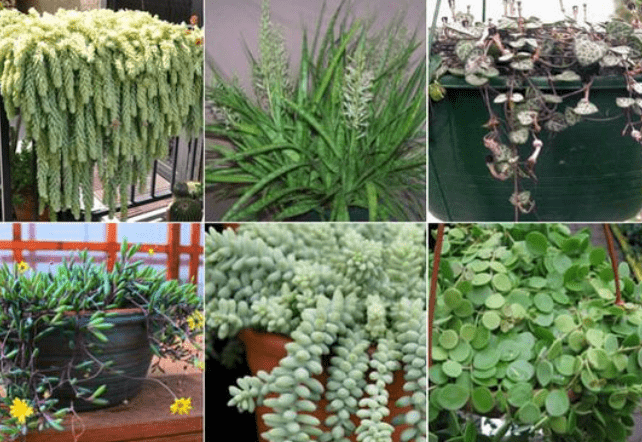
Considerations such as drainage, size, and material
Considerations such as drainage, size, and material are important when selecting the right hanging container for your succulent plants. Proper drainage is crucial for the health of your succulents, as they are prone to root rot if their roots are sitting in water for too long. Look for pots or containers with drainage holes to ensure that excess water can escape and prevent waterlogged soil. Additionally, consider the size of the container in relation to the size of your succulents. You want to make sure there is enough space for the roots to grow and thrive. The material of the container is also important, especially if you are hanging it from a ceiling or a wall. Lightweight materials such as plastic or fiberglass are ideal for hanging displays, as they reduce the risk of the container falling and causing damage. It’s also important to choose a container that complements the aesthetic of your space and allows the succulents to thrive. By considering these factors, you can create a beautiful and healthy hanging succulent display.
Tips for DIY hanging containers or repurposing existing ones
Creating your own hanging succulent display can be a fun and rewarding DIY project. When repurposing existing containers or choosing new ones, there are a few key tips to keep in mind. Look for pots or containers with drainage holes to ensure that excess water can escape and prevent waterlogged soil. This will help to promote healthy root growth and prevent the risk of root rot. Additionally, consider the size of the container in relation to the size of your succulents. You want to make sure there is enough space for the roots to grow and thrive. The material of the container is also important, especially if you are hanging it from a ceiling or a wall. Lightweight materials such as plastic or fiberglass are ideal for hanging displays, as they reduce the risk of the container falling and causing damage. It’s also important to choose a container that complements the aesthetic of your space and allows the succulents to thrive. By considering these factors, you can create a beautiful and healthy hanging succulent display that adds a touch of greenery to your home.
Ideal Growing Conditions
Optimal light requirements for hanging succulents
Optimal light requirements for hanging succulents are crucial to their overall health. Succulents thrive in bright, indirect light, so it’s important to place them in a location where they can receive plenty of sunlight without being exposed to harsh, direct rays. If you are hanging your succulents indoors, consider placing them near a south or west-facing window where they can get adequate light. If you are hanging them outdoors, make sure to choose a location that receives partial sunlight throughout the day. It’s important to monitor the light conditions and adjust as needed to ensure your succulents are getting the optimal amount of light for their growth.
In addition to light, it’s important to consider the size of the container in relation to the size of your succulents. You want to make sure there is enough space for the roots to grow and thrive. The material of the container is also important, especially if you are hanging it from a ceiling or a wall. Lightweight materials such as plastic or fiberglass are ideal for hanging displays, as they reduce the risk of the container falling and causing damage.
Lastly, it’s important to choose a container that complements the aesthetic of your space and allows the succulents to thrive. By considering these factors, you can create a beautiful and healthy hanging succulent display that adds a touch of greenery to your home or outdoor space.
Temperature and humidity considerations
Temperature and humidity considerations are important factors to keep in mind when caring for your succulents. Succulents thrive in warm and dry conditions, so it’s important to ensure that they are not exposed to extreme temperature fluctuations or high humidity levels. When the temperature drops below 50°F, it’s best to bring your succulents indoors to protect them from the cold. On the other hand, if the temperature rises above 90°F, it’s important to provide some shade to prevent your succulents from getting sunburned. In terms of humidity, succulents do not like to be in high humidity environments, as this can lead to root rot and other issues. It’s important to provide good air circulation and avoid overwatering to prevent moisture from accumulating around the roots. By taking these temperature and humidity considerations into account, you can ensure that your succulents are in the best possible growing conditions.
Soil types and proper watering techniques
Soil types and proper watering techniques are crucial factors to consider when caring for succulents. Succulents thrive in well-draining soil that allows excess water to flow through easily, preventing root rot. A mixture of sandy, gritty soil is ideal for succulents as it mimics their natural habitat. When it comes to watering, it’s important to avoid overwatering, as succulents are adapted to surviving in arid conditions. Water your succulents thoroughly but infrequently, allowing the soil to dry out completely between waterings. It’s also important to water the soil directly, rather than the leaves, to prevent rot and fungal diseases. By understanding the specific soil and watering needs of succulents, you can ensure that they thrive and remain healthy.
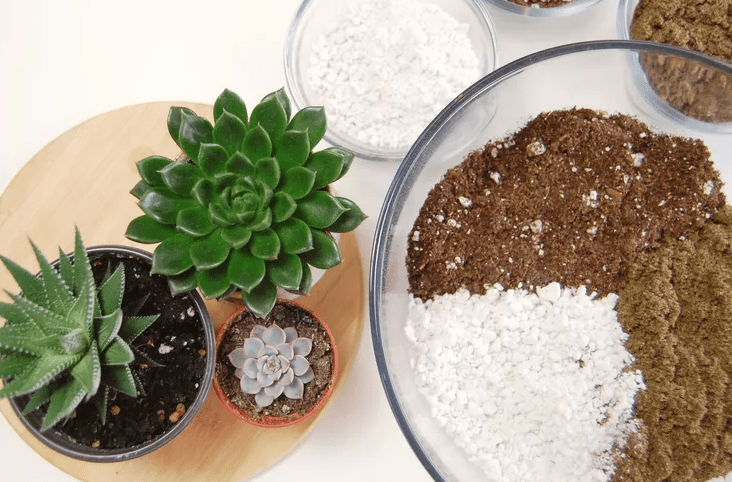
Planting and Potting
Step-by-step guide to planting hanging succulents
- Choose the right container: Select a hanging pot that has drainage holes to prevent water from pooling at the bottom and causing root rot.
- Add a layer of drainage material: Place a layer of gravel or small stones at the bottom of the pot to further aid in drainage.
- Prepare the soil: Use a well-draining, succulent-specific soil mix or create your own by mixing equal parts potting soil with sand or perlite.
- Select your succulents: Choose smaller, trailing succulents that are well-suited for hanging pots, such as string of pearls, donkey’s tail, or burro’s tail.
- Plant your succulents: Remove your succulents from their nursery pots and gently loosen the roots. Then, plant them in the prepared soil, making sure to position them securely in the pot.
- Water sparingly: After planting, water your succulents lightly and allow the soil to dry out completely before watering again.
- Hang and display: Once your succulents are planted, hang your pot in a location that receives plenty of bright, indirect sunlight. Monitor the soil moisture and adjust your watering schedule as needed to ensure your hanging succulents thrive.
Tips on potting mixtures and layering for drainage
When planting succulents in hanging pots, it’s important to prepare the soil properly. You can either use a well-draining succulent-specific soil mix or create your own by mixing equal parts potting soil with sand or perlite. Once you have your soil prepared, select smaller, trailing succulents that are well-suited for hanging pots, such as string of pearls, donkey’s tail, or burro’s tail. When planting your succulents, be sure to remove them from their nursery pots and gently loosen the roots before planting them securely in the pot. After planting, water your succulents lightly and allow the soil to dry out completely before watering again. Hang your pot in a location that receives plenty of bright, indirect sunlight, and monitor the soil moisture to ensure your hanging succulents thrive. With the right potting mix and proper drainage, your succulents will be sure to flourish in their hanging pots.
How to position plants for aesthetic and growth benefits
When it comes to positioning plants for both aesthetic appeal and growth, there are a few key things to consider. First, you’ll want to take into account the specific lighting needs of the plant. Some plants thrive in direct sunlight, while others prefer shade. Make sure to place your plants in locations that provide the right amount of light for their specific needs.
In addition to lighting, you’ll also want to consider the overall aesthetic of your space. Grouping plants together in complementary arrangements can create a visually appealing display. Consider mixing different types of plants with varying heights and textures to add interest to your arrangement.
Furthermore, you should also consider the growth habits of the plants. Make sure to leave enough space between plants to allow for proper growth and prevent overcrowding. Additionally, consider the eventual size of the plants and position them accordingly to prevent them from outgrowing their space.
Lastly, consider the environmental factors such as humidity and temperature in the area where you’re placing your plants. Some plants thrive in high humidity, while others prefer drier conditions. Pay attention to the specific needs of your plants and position them in locations that will allow them to thrive. By taking these factors into consideration, you can create both a visually appealing and healthy growing environment for your plants.
Watering and Maintenance
Detailed watering schedule and methods
Detailed watering schedule and methods are crucial to the health and growth of your plants. It’s important to establish a regular watering schedule based on the specific needs of each plant. Some plants may require more frequent watering, while others may only need to be watered once a week. Be sure to water the roots of the plants and avoid getting the leaves wet, as this can lead to mold and disease. In addition to the frequency of watering, the method of watering is also important. For example, some plants may benefit from deep watering, while others may do better with a light misting. It’s important to research the specific watering needs of each plant and adjust your watering methods accordingly. Additionally, consider using a soaker hose or drip irrigation system to ensure that water is distributed evenly and efficiently. By paying attention to the watering needs of your plants and using the appropriate methods, you can help them thrive and grow to their full potential.
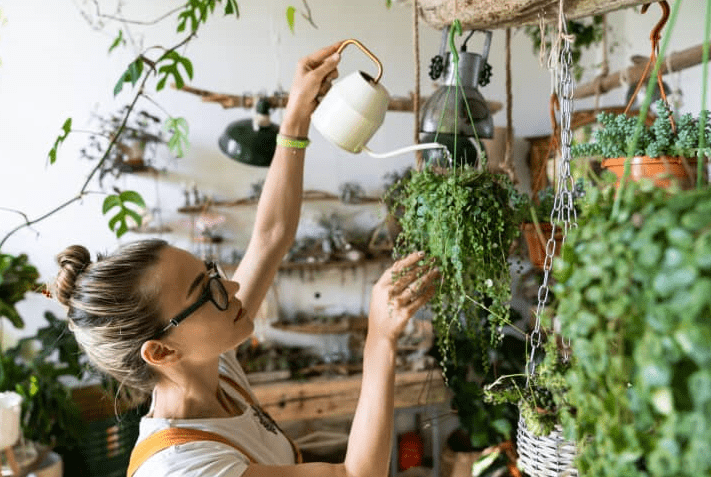
Pruning and Propagation
Techniques for trimming and shaping hanging succulents
When it comes to trimming and shaping hanging succulents, it’s important to consider the specific needs of each plant. Some succulents may need more frequent pruning to maintain their shape, while others may require minimal trimming. When pruning, be sure to use clean, sharp tools to avoid damaging the plant. You can also propagate succulents by taking cuttings and allowing them to root in a well-draining soil mix. This can help you create new plants and maintain the overall health and appearance of your hanging succulents. Be sure to research the specific needs of your succulents and adjust your pruning and propagation techniques accordingly to ensure their continued growth and beauty.
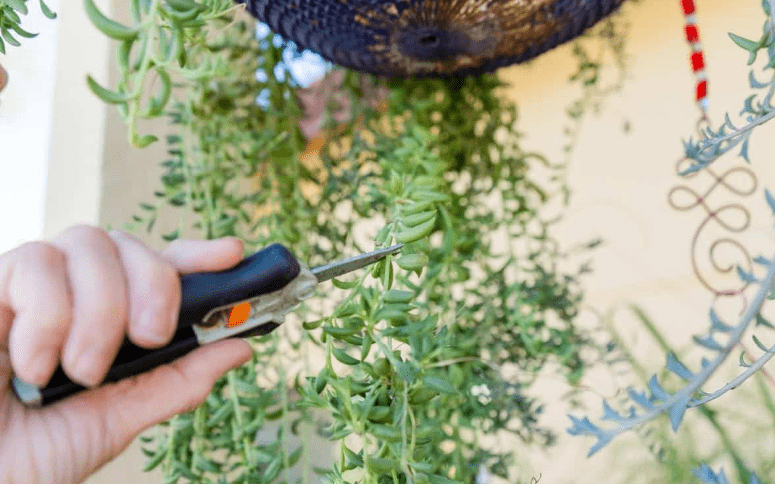
Guide to propagating succulents from cuttings or offsets
Propagating succulents from cuttings or offsets is a great way to expand your succulent collection. To propagate succulents from cuttings, start by choosing a healthy, mature plant and using a clean, sharp knife or scissors to cut a piece of the stem. Allow the cutting to dry for a few days, then plant it in a well-draining soil mix and water sparingly until new roots develop. For offsets, gently remove the offset from the parent plant and allow it to dry for a few days before planting it in its own pot with well-draining soil. Water sparingly until the new plant establishes itself. It’s important to provide the right amount of sunlight and water for the new plants to thrive. With the proper care and attention, you can successfully propagate succulents from cuttings or offsets and enjoy a beautiful, expanding collection of these unique and low-maintenance plants.
Common Pests and Diseases
Organic methods for pest control and prevention
When it comes to pest control and prevention for your plants, organic methods are a great option. One method is to use natural predators, such as ladybugs, to control pest populations. You can also use insecticidal soaps or oils to treat infestations in a safe and environmentally friendly way. Additionally, maintaining healthy soil and plants through proper watering, pruning, and fertilization can help prevent pest and disease problems. By using organic methods, you can protect your plants while also being mindful of the environment.
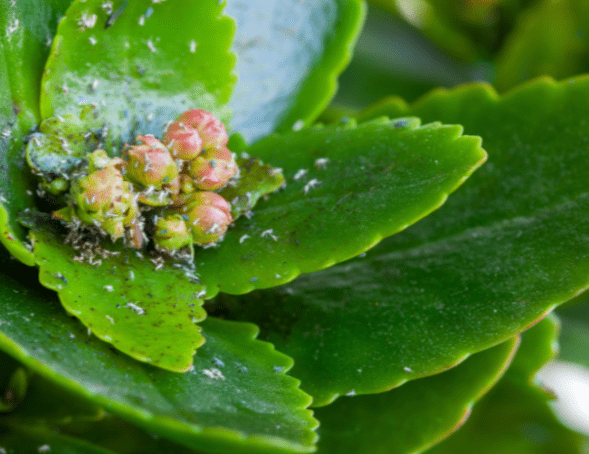
Common diseases and how to address them effectively
When it comes to common diseases in plants, it’s important to be proactive in addressing them effectively. One common issue is powdery mildew, which can be treated with a fungicide or by pruning affected areas. Another common disease is root rot, which can be prevented by ensuring proper drainage and avoiding overwatering. It’s also important to regularly inspect your plants for any signs of disease and address them promptly to prevent spread. In addition to addressing diseases, it’s important to focus on preventive measures such as maintaining proper soil health, providing adequate sunlight and water, and using organic pest control methods. By taking a proactive approach to plant health, you can effectively address and prevent common diseases.
In conclusion, hanging succulent plants can add a unique and beautiful touch to any space. By following the care tips and stunning display ideas provided in this guide, you can ensure that your succulents thrive and create a stunning visual impact. Whether you’re a beginner or experienced succulent enthusiast, this ultimate guide has everything you need to create a beautiful and thriving display of hanging succulent plant.
Frequently asked questions And Answer
Succulent plants need plenty of bright, indirect sunlight. Place them near a window where they can receive sunlight for at least 6 hours a day.
It’s important to let the soil dry out completely between waterings. Depending on the climate and the type of succulent, this could mean watering every 1-2 weeks.
It’s best to use a well-draining cactus or succulent mix for planting succulents. Regular potting soil can hold too much moisture and lead to root rot.
Succulents can be displayed in a variety of containers such as terrariums, hanging planters, or even unconventional items like teacups or mason jars. You can also create a stunning vertical garden with a variety of succulent species.
Yes, succulent plants can thrive indoors as long as they receive enough sunlight. Just be sure to provide proper drainage and avoid overwatering.
Succulents have low fertilizer needs, and too much fertilizer can actually harm them. Use a balanced, water-soluble fertilizer diluted to half strength and apply it during the growing season.
Succulents can be propagated through leaf or stem cuttings, division, or offsets. Each method requires different steps, so it’s best to research the specific propagation method for the type of succulent you have.
Overwatering can lead to root rot, while mealybugs, aphids, and spider mites are common pests that can affect succulents. It’s important to monitor your plants regularly and address any issues promptly.
